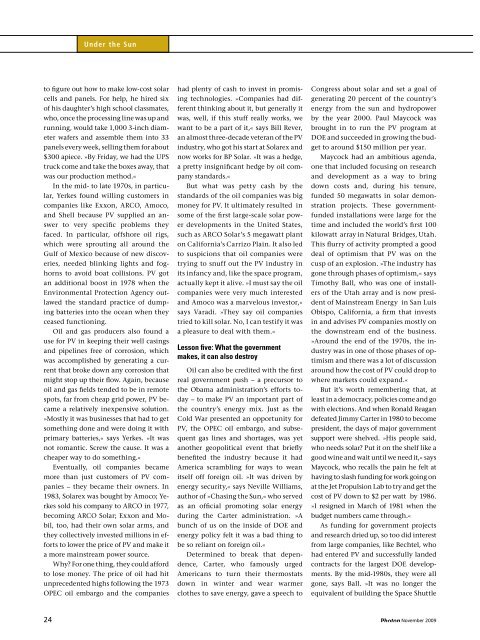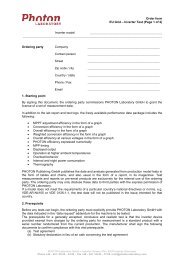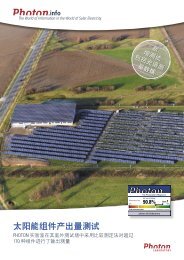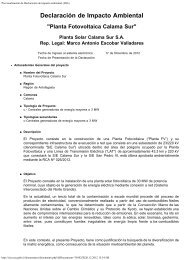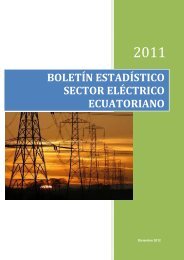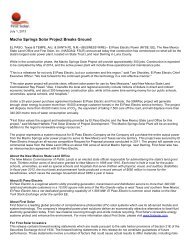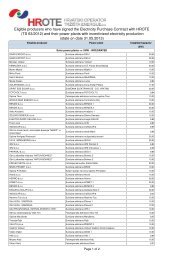INTRODUCTORY SPECIAL INTRODUCTORY ... - PHOTON Info
INTRODUCTORY SPECIAL INTRODUCTORY ... - PHOTON Info
INTRODUCTORY SPECIAL INTRODUCTORY ... - PHOTON Info
Create successful ePaper yourself
Turn your PDF publications into a flip-book with our unique Google optimized e-Paper software.
Under the Sun<br />
to figure out how to make low-cost solar<br />
cells and panels. For help, he hired six<br />
of his daughter’s high school classmates,<br />
who, once the processing line was up and<br />
running, would take 1,000 3-inch diam-<br />
eter wafers and assemble them into 33<br />
panels every week, selling them for about<br />
$300 apiece. »By Friday, we had the UPS<br />
truck come and take the boxes away, that<br />
was our production method.«<br />
24<br />
In the mid- to late 1970s, in particu-<br />
lar, Yerkes found willing customers in<br />
companies like Exxon, ARCO, Amoco,<br />
and Shell because PV supplied an an-<br />
swer to very specific problems they<br />
faced. In particular, offshore oil rigs,<br />
which were sprouting all around the<br />
Gulf of Mexico because of new discov-<br />
eries, needed blinking lights and fog-<br />
horns to avoid boat collisions. PV got<br />
an additional boost in 1978 when the<br />
Environmental Protection Agency out-<br />
lawed the standard practice of dump-<br />
ing batteries into the ocean when they<br />
ceased functioning.<br />
Oil and gas producers also found a<br />
use for PV in keeping their well casings<br />
and pipelines free of corrosion, which<br />
was accomplished by generating a cur-<br />
rent that broke down any corrosion that<br />
might stop up their flow. Again, because<br />
oil and gas fields tended to be in remote<br />
spots, far from cheap grid power, PV be-<br />
came a relatively inexpensive solution.<br />
»Mostly it was businesses that had to get<br />
something done and were doing it with<br />
primary batteries,« says Yerkes. »It was<br />
not romantic. Screw the cause. It was a<br />
cheaper way to do something.«<br />
Eventually, oil companies became<br />
more than just customers of PV com-<br />
panies – they became their owners. In<br />
1983, Solarex was bought by Amoco; Ye-<br />
rkes sold his company to ARCO in 1977,<br />
becoming ARCO Solar; Exxon and Mo-<br />
bil, too, had their own solar arms, and<br />
they collectively invested millions in ef-<br />
forts to lower the price of PV and make it<br />
a more mainstream power source.<br />
Why? For one thing, they could afford<br />
to lose money. The price of oil had hit<br />
unprecedented highs following the 1973<br />
OPEC oil embargo and the companies<br />
had plenty of cash to invest in promis-<br />
ing technologies. »Companies had dif-<br />
ferent thinking about it, but generally it<br />
was, well, if this stuff really works, we<br />
want to be a part of it,« says Bill Rever,<br />
an almost three-decade veteran of the PV<br />
industry, who got his start at Solarex and<br />
now works for BP Solar. »It was a hedge,<br />
a pretty insignificant hedge by oil com-<br />
pany standards.«<br />
But what was petty cash by the<br />
standards of the oil companies was big<br />
money for PV. It ultimately resulted in<br />
some of the first large-scale solar pow-<br />
er developments in the United States,<br />
such as ARCO Solar’s 5 megawatt plant<br />
on California’s Carrizo Plain. It also led<br />
to suspicions that oil companies were<br />
trying to snuff out the PV industry in<br />
its infancy and, like the space program,<br />
actually kept it alive. »I must say the oil<br />
companies were very much interested<br />
and Amoco was a marvelous investor,«<br />
says Varadi. »They say oil companies<br />
tried to kill solar. No, I can testify it was<br />
a pleasure to deal with them.«<br />
Lesson five: What the government<br />
makes, it can also destroy<br />
Oil can also be credited with the first<br />
real government push – a precursor to<br />
the Obama administration’s efforts to-<br />
day – to make PV an important part of<br />
the country’s energy mix. Just as the<br />
Cold War presented an opportunity for<br />
PV, the OPEC oil embargo, and subse-<br />
quent gas lines and shortages, was yet<br />
another geopolitical event that briefly<br />
benefited the industry because it had<br />
America scrambling for ways to wean<br />
itself off foreign oil. »It was driven by<br />
energy security,« says Neville Williams,<br />
author of »Chasing the Sun,« who served<br />
as an official promoting solar energy<br />
during the Carter administration. »A<br />
bunch of us on the inside of DOE and<br />
energy policy felt it was a bad thing to<br />
be so reliant on foreign oil.«<br />
Determined to break that depen-<br />
dence, Carter, who famously urged<br />
Americans to turn their thermostats<br />
down in winter and wear warmer<br />
clothes to save energy, gave a speech to<br />
Congress about solar and set a goal of<br />
generating 20 percent of the country’s<br />
energy from the sun and hydropower<br />
by the year 2000. Paul Maycock was<br />
brought in to run the PV program at<br />
DOE and succeeded in growing the bud-<br />
get to around $150 million per year.<br />
Maycock had an ambitious agenda,<br />
one that included focusing on research<br />
and development as a way to bring<br />
down costs and, during his tenure,<br />
funded 50 megawatts in solar demon-<br />
stration projects. These government-<br />
funded installations were large for the<br />
time and included the world’s first 100<br />
kilowatt array in Natural Bridges, Utah.<br />
This flurry of activity prompted a good<br />
deal of optimism that PV was on the<br />
cusp of an explosion. »The industry has<br />
gone through phases of optimism,« says<br />
Timothy Ball, who was one of install-<br />
ers of the Utah array and is now presi-<br />
dent of Mainstream Energy in San Luis<br />
Obispo, California, a firm that invests<br />
in and advises PV companies mostly on<br />
the downstream end of the business.<br />
»Around the end of the 1970s, the in-<br />
dustry was in one of those phases of op-<br />
timism and there was a lot of discussion<br />
around how the cost of PV could drop to<br />
where markets could expand.«<br />
But it’s worth remembering that, at<br />
least in a democracy, policies come and go<br />
with elections. And when Ronald Reagan<br />
defeated Jimmy Carter in 1980 to become<br />
president, the days of major government<br />
support were shelved. »His people said,<br />
who needs solar? Put it on the shelf like a<br />
good wine and wait until we need it,« says<br />
Maycock, who recalls the pain he felt at<br />
having to slash funding for work going on<br />
at the Jet Propulsion Lab to try and get the<br />
cost of PV down to $2 per watt by 1986.<br />
»I resigned in March of 1981 when the<br />
budget numbers came through.«<br />
As funding for government projects<br />
and research dried up, so too did interest<br />
from large companies, like Bechtel, who<br />
had entered PV and successfully landed<br />
contracts for the largest DOE develop-<br />
ments. By the mid-1980s, they were all<br />
gone, says Ball. »It was no longer the<br />
equivalent of building the Space Shuttle<br />
November 2009


